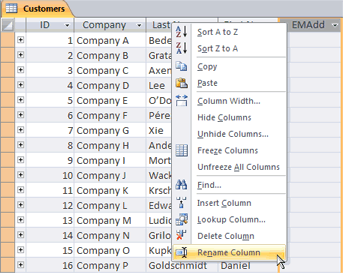

- How to select columns on microsoft access on mac how to#
- How to select columns on microsoft access on mac windows#
Top of Page Remove a column by using Datasheet viewīefore you remove a column from a datasheet, remember several important facts: Right-click the column header and click Rename Field on the shortcut menu. For information about setting data types manually, see Set the data types that Datasheet view does not infer, also later in this article.ĭouble-click the column header and enter a name for the new field. For example, if you enter a name, Access sets the data type to Text.įor more information about how Access sets data types, see the section Understand how Access assigns data types as you enter information. Paste one or more pieces of data into the field, starting with the first blank cell.īased on the type of data you enter, Access sets a data type for the field.
How to select columns on microsoft access on mac windows#
Scroll to the right or left side of the datasheet (depending on your Windows Regional and Language settings), and locate the blank column.īy default, the words Click to Add appear in the column header of the blank column.Įnter some data in the first blank row beneath the header. In the Navigation Pane, locate and double-click the table to which you want to add the field.Īccess opens the table in Datasheet view. As you proceed, remember that following these steps adds and changes a field in the table that underlies your datasheet.
How to select columns on microsoft access on mac how to#
The steps in this section explain how to use Datasheet view to add a column to a datasheet, give the column a name, and enter data. The steps in the following sections explain how to add and remove columns in datasheets by using Datasheet view and Design view. If you are not familiar with design rules for relational databases, see the article Database design basics. For more information, see the section Understand how Access assigns data types as you enter information, later in this article.įor more information about setting data types, see the article Data types for Access desktop databases. If you paste a mix of data, such as postal codes from several countries/regions, Access selects the data type that does the best job of preserving the information - usually, the Text data type. If you paste a date, Access sets the field to the Date/Time data type, and so on. For example, if you enter a name in the first field in your new table, Access sets that field to the Text data type. However, Access now infers most data types when you first enter data in a new column. Typically, you set data types when you design the tables for a database. By default, the fields in a database table must contain specific types of data, such as text, dates and times, numbers, and so on. In addition, you no longer have to set the more common data types for the new column.

You no longer need to use Design view to add or remove columns, although you can if you want. You can also paste one or more pieces of data into the blank column. To add a column, you enter data into the first blank cell beneath that column header. By default, all tables in Datasheet view now contain a blank column labeled Click to Add. Working with columnsĪccess makes it faster and easier to add or remove a table field because you can perform those tasks in Datasheet view. If that field contains data, you also eliminate that information. When you add or remove a column from a datasheet, you add or remove a field from the table that underlies the datasheet. A column in a datasheet represents the same thing as a field in a database table. Set the data types that Datasheet view does not inferĪ datasheet is the visual representation of the information contained in a database table, or of the results returned by a query. Understand how Access assigns data types as you enter information This topic explains how to use each method.įor more information about creating and using datasheets, see the articles Create a form using the Datasheet tool and Working with datasheets.

You can also add fields from a task pane, or you can open the table that underlies the datasheet and add a field in Design view. You can use Datasheet view to add or remove columns and set the data types for those columns. LessĪccess provides several ways to add or remove the columns in a datasheet. Access for Microsoft 365 Access 2021 Access 2019 Access 2016 Access 2013 Access 2010 Access 2007 More.


 0 kommentar(er)
0 kommentar(er)
